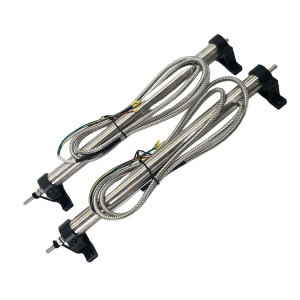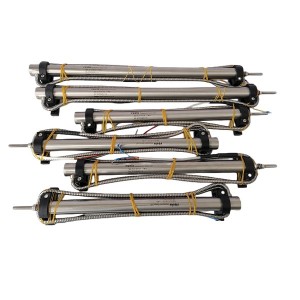As a high-precision and high-reliability linear displacement sensor, the linear variable differential transformer is widely used in industrial automation and control. In turbomachinery, such as steam turbines, the actuator is used as an actuator, and the accurate measurement of its stroke is crucial to the stable operation of the system. LVDT sensors are often used for feedback measurement of the actuator stroke of steam turbines. However, the actuator usually works in a high-temperature oil environment. The high temperature of the oil itself and the heat generated by the operation of the equipment will be transferred to the LVDT sensor, causing its internal components to change in size due to thermal expansion, thereby affecting the measurement accuracy and long-term stability of the sensor. For the actuator stroke LVDT sensor model K186.33.01.06G01, careful structural design is used to effectively reduce the adverse effects of thermal expansion, which is the key to ensure its reliable operation in a high-temperature oil environment.
1. The impact of high-temperature oil environment on LVDT sensors
The LVDT sensor consists of a primary coil, a secondary coil, an iron core, and a supporting structure. In a high-temperature oil environment, the various components of the sensor, especially those made of different materials, will undergo different degrees of dimensional changes due to differences in thermal expansion coefficients. This inconsistent expansion can lead to the following problems:
- Sensor body size change: The expansion of the sensor housing, coil frame, core and other components will directly change the physical size of the sensor, affecting its installation and fixation.
- Relative displacement of internal components: The relative position change between the primary coil, secondary coil and core is the key to the LVDT output signal. The difference in expansion of different components will cause these relative positions to change, thereby introducing measurement errors.
- Risk of seal failure: High temperature will accelerate the aging and deformation of the sealing material, reduce its sealing performance, increase the risk of oil penetrating into the sensor, and affect the electrical performance and life of the sensor.
- Material performance degradation: In a high-temperature oil environment for a long time, the insulation material, coil wire, etc. inside the sensor may degrade in performance, affecting the reliability of the sensor.

Therefore, for the application of LVDT displacement sensor K186.33.01.06G01 in a high-temperature oil environment, effective measures must be taken in structural design to minimize the adverse effects of thermal expansion.
2. Thermal expansion suppression strategy based on structural design
In view of the above problems, the following structural design strategies can be used to reduce the thermal expansion effect of LVDT sensor K186.33.01.06G01 in high-temperature oil environment:
1. Selection and combination of high-temperature resistant materials:
Sensor housing: Selecting stainless steel or special alloy materials with low thermal expansion coefficient as the sensor housing can effectively reduce the overall size change of the housing.
Coil skeleton and iron core: Consider using materials with ultra-low thermal expansion coefficient such as Invar alloy to manufacture coil skeletons and iron cores to minimize the size change of these key components and reduce the relative displacement between them.
High-temperature sealing materials: Select sealing materials that are resistant to high temperature and oil corrosion to ensure the sealing reliability of displacement sensor K186.33.01.06G01 in high-temperature oil environment and prevent oil infiltration.
2. Symmetrical structure and thermal isolation design:
Symmetrical structure: The symmetrical structural design allows the K186.33.01.06G01 sensor to expand evenly after heating, reducing deformation and stress concentration caused by uneven local heating. For example, the winding of the coil and the shape of the core can be designed symmetrically.
Thermal isolation: By setting an insulation layer inside the sensor or using a material with low thermal conductivity as a connector, the heat source (such as the oil motor body) is isolated from the key measuring parts of the sensor as much as possible, slowing down heat transfer and reducing the operating temperature of the sensor.

3. Elastic installation and floating connection:
Elastic installation: The sensor is installed on the oil motor using an elastic bracket or flexible connector, allowing the sensor to expand and contract freely within a certain range, reducing the mechanical stress caused by the expansion difference with the oil motor body.
Floating connection: For the movable parts of the sensor (such as the core connecting rod), a floating connection method is used to allow it to move freely within a certain range, reducing the stagnation or deformation caused by thermal expansion.
The reliability and measurement accuracy of the actuator position LVDT sensor K186.33.01.06G01 in a high-temperature oil environment are crucial. By comprehensively considering the selection and combination of low thermal expansion coefficient materials, symmetrical structure and thermal isolation design, heat dissipation structure design, high-temperature sealing and pressure balance design, elastic installation and floating connection, and calibration and compensation in a high-temperature environment in the structural design, the adverse effects of thermal expansion on the sensor performance can be effectively reduced, ensuring that it can work stably and reliably in a high-temperature oil environment for a long time, providing strong guarantees for the precise control of the oil motor and the safe operation of the entire turbomachinery system.

When looking for high-quality, reliable LVDT sensors, YOYIK is undoubtedly a choice worth considering. The company specializes in providing a variety of power equipment including steam turbine accessories, and has won wide acclaim for its high-quality products and services. For more information or inquiries, please contact the customer service below:
E-mail: sales@yoyik.com
Tel: +86-838-2226655
Whatsapp: +86-13618105229
Yoyik offers various types of spare parts for steam turbines, generators, boilers in power plants:
Level gauge YZF2-200TH
Speed sensor SMCB-1
Temperature Transmitter JM-B-T010-562D2
Large bolt electric heater ZJ-20-75
Temperature Sensor WZP-001D
bolts heater 1.2311(4)-φ18X1300
TSI Communication card A6500-CC
proximity sensor SZCB01
Differential Pressure Switch 12NN-K5-N4-B1A
magnetic pickup speed sensor DF6101-005-065-01-05-00-00
Front end of objective lens YF-A18-5A-2-2(B)
DIFFERENTIAL PRESSURE SWITCH 101NN-KK3-N1-C1A
SENSOR O₂ 3D39645G
Transient data acquire and monitor module SY4400
Pulse Module Advantech 6 Channels ADAM 5081S-BE
Pressure Switch 5NN-K5-N4-F1A
Acoustic sensor DZXL-VI-T/E2
PHOTOELECTRIC LEVEL SWITCH GDK-1 24V
Wind-direction & wind speed transmitter YF6-8B
Gbr (Limit Switch)For Screws XCK-J0541
FAN RG130/0800-3612-030206
Sensor K156.33.31.04G01
indicator RC860MZ091ZSS
Sensor SMCB-01-16L
Indicator RDZW-2Na04-B02-C01-F01
OIL LEVEL INDICATOR YZF2-250TH
IR sulfur analysis cell 5E-IRSII (S09)
LIMIT SWITCH TA 471-02/02Y
Displacement Sensors TBIW0027 BIW1-E310-M0130-P 1-S115
Limit Switch WLGCA2
Rectifier TEP-M30/220-F
PROXIMITY SENSOR VMS808-21-50-00-00
Displacement Sensors 0508.1927T0101.AW001
GAUGE PRESSURE E3144232-02
Post time: Apr-23-2025













